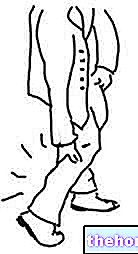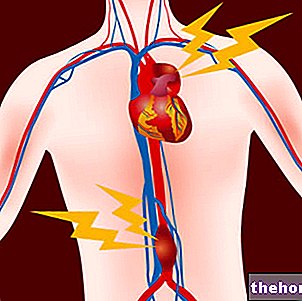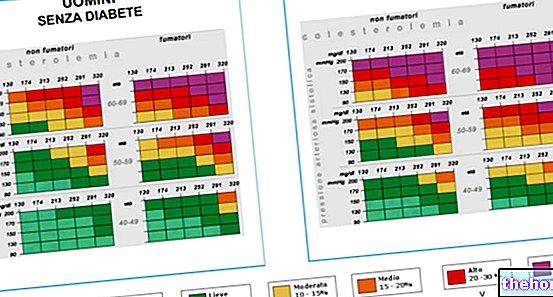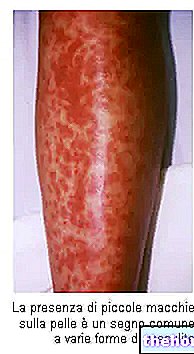Biological role
As the term itself suggests, endothelin is a family of peptides secreted by endothelial cells. Their action is vasoconstrictive and markedly hypertensive.
Endothelium Physiology
Together, the endothelial cells constitute the innermost lining of the blood vessels, therefore they represent the contact element between the blood and the arterial wall. This interface, once considered a mere coating, is currently described as a real organ, dynamic and complex. Among the best known substances secreted by about 3 kg of endothelium present in an average organism, we remember:
- Nitric oxide: gas released rapidly in response to various vasodilatory stimuli and then inactivated within a few seconds, it exerts a "vasodilating and therefore hypotensive action and inhibits the production of ET-1
- Endothelin (ET-1): peptide with a vasoconstrictive action, therefore hypertensive, which arises slowly and lasts from minutes to hours. Its synthesis also seems to increase that of nitric oxide, which in turn reduces the vasoconstriction induced by endothelin with effect rebalancing
- Prostacyclines (PGI2): inhibit platelet aggregation and act as vasodilators
Normally there is a balance between vasoconstrictive and vasodilating factors, but when endothelins are synthesized in excessive quantities, they contribute to the onset of hypertension and heart disease.
Three isoforms of endothelin are currently known:
Endothelin-1 (ET-1) is a peptide of 21 amino acids: it is the only or in any case the main isoform synthesized by the endothelium, isolated for the first time by Yanagisawa in 1988; it is also synthesized to a lesser extent by smooth muscle , from the intestine and adrenal glands, and in good quantities also from the kidney and brain
The ET-2 and ET-3 endothelins are instead peptides, always made up of 21 amino acids, synthesized in other body sites: ET-2 is much less widely distributed and is mainly present in the kidney and intestine; ET-3 is concentrated in the brain, lungs, intestines and adrenal glands

The synthesis of ET-1, schematically shown in the figure, is very complex: it starts from a large precursor molecule, the preproendothelin, which then undergoes a series of enzymatic interventions that reduce it first to "big endothelin" (big ET) and then - by the action of the "endothelin conversion enzyme (ECE-1 or Endothelin converting enzyme) - to Endothelin 1 (ET-1).
The synthesis of endothelin-1 is stimulated by numerous factors with vasoconstrictive action, released during trauma or inflammatory states
thrombin, angiotensin II, catecholamines, vasopressin, bradykinin, hypoxia, pro-inflammatory cytokines (interleukin-1, the Tumor Necrosis Factor-α)
while it is inhibited by:
nitric oxide, natriuretic peptides, heparin, PGE2, PGI2, high creep stress
Functions
In addition to its powerful vasoconstrictive properties, especially aimed at coronary, renal and cerebral vessels with an "intensity 10 times greater than that of angiotensin - endothelin 1 also performs an" action:
- positive inotropic on the heart (increases the force of contraction)
- stimulation of cell proliferation, with a mitogenic effect on vascular smooth muscle cells
- modulator of the activities of the sympathetic system and of the renin angiotensin system
Clinical significance
In physiological conditions, the blood concentration of ET-1 is rather low, and in any case lower than that capable of exerting the vasoconstrictive action. The endothelin therefore play a leading role in maintaining the basal vascular tone, acting in synergy with others. factors.
In addition to increasing blood pressure, entothelin-1 plays an important role in inflammation and atherogenesis. In fact, a massive increase in plasma endothelin rate occurs during severe cardiovascular events, such as cardiogenic shock, acute heart attack. heart disease, major surgery and liver transplantation.
- the plasma concentration of ET is maximum in the early stages of acute myocardial infarction and gradually decreases in the following hours
- in case of complicated acute myocardial infarction, the endothelin values remain elevated even for several days.
As a laboratory marker, endothelin-1 levels therefore seem inversely proportional to the patient's survival time (the higher and more persistent they are, the more severe the patient's condition is):
Endothelin-1 levels are also elevated in the presence of:
- pulmonary hypertension
- heart failure
- kidney failure
- renal ischemia
- cirrhosis and ascites
while in the presence of arterial hypertension, the experimental data appear somewhat discordant, so much so that in general the endothelin levels are comparable to those found in normotensive patients. In general, however, ET-1 levels are higher in hypertensive patients with advanced disease, probably due to vascular complications related to hypertension.
Endothelin receptors
To carry out their action, endothelin interact with at least two different receptor subtypes:
- AGE:
- HYPERTENSIVE EFFECT → vasoconstriction, increased contraction force of the heart and blood concentration of aldosterone, with consequent sodium retention
- high affinity for ET-1 and to a lesser extent for ET-2
- expressed mainly at the level of vascular smooth muscle
- ET-B:
- HYPOTENSIVE EFFECT → the stimulation of these receptors - secondary to the increase in the production of nitric oxide - induces vasodilation with the aim of modulating (dampening) the vasoconstrictive and mitogenic effects of endothelin
- equal affinity for the three isoforms
- expressed mainly in the endothelial and smooth muscle cells
The existence of a third type of receptor has also been proposed
- ET-C:
- HYPOTENSIVE EFFECT
- high affinity for ET-3
- mainly expressed in the nervous system
Endothelin and antihypertensive drugs
Having clarified, at least broadly, the biological role of endothelin, the efforts of the researchers focused on the synthesis of drugs capable of blocking their binding to the ET-A receptor, or reducing their synthesis by blocking the activity of the enzyme ECE- 1 (Endothelin converting enzyme); in both cases, the purpose of the drug was to cancel the vasoconstrictor, and therefore hypertensive, effect of endothelin, thus obtaining very useful drugs in the treatment of hypertension and in the prevention of its complications, especially in the kidney.
A drug that has recently entered therapy is bosentan, a double antagonist of the ETa and ETB receptor, taken orally and used in the treatment of pulmonary arterial hypertension. Other drugs, such as ambrisentan and sitaxentan, act as selective receptor antagonists Age.




























